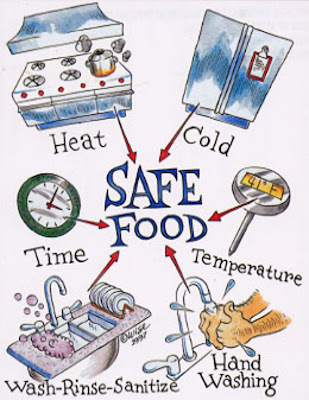What is date marking and how is it used?
Date marking is an identification system for ready-to-eat foods
held over 24 hours so you know how old they are. The system helps to identify
when food is to be discarded. Date marking ensures food safety, and it is the
law.
How do I know if a food needs to be date marked?
If you answer “yes” to all five of these questions, then the food
MUST be date marked.
1. Does the food require
refrigeration?
2. If commercially
packaged, has the original package been opened?
3. Could the food be
eaten just like it is, regardless of temperature? Examples: cold cooked meats,
potatoes, pastas, soups, stews, cole slaw, tartar sauce, sour cream and cottage
cheese.
4. Is the food
potentially hazardous? Will it mold or grow bacteria? Will the food support
bacterial or viral foodborne organism growth? Example: listeria monocytogenes
is associated with soft cheese.
5. Will the food be in
the establishment for more than 24 hours? This counts even if the food is, or
will be, mixed with something else to form a new product.
If the food has an expiration date on it, isn’t
that the same as a date mark?
No, the expiration date is the date through which the manufacturer
guarantees the food will meet their quality standards. Date marking ensures the
safety of the food.
The establishment goes through food so fast! Even
if it is going to be gone in less than 4 to 7 days, do I still need to date
mark it?
Yes, if the food is not going to be served or discarded within 24
hours, it MUST be date marked.
When should I discard food?
When refrigeration is at 41°F or below, discard within 7 days
(date of prep/opening + 6days).
What if I freeze the food?
Freezing food pauses the date marking clock but does not reset it.
For example, if a food is stored at 4°F for 2 days and then frozen, it can
still be stored at 4°F for 2 more days when it begins to thaw.
What if I mix the food with something else?
When foods are mixed together the date of the oldest food becomes
the new date for the mixed food. For example, if today is Wednesday, and you
are mixing a food that was marked on Monday with a food that was marked
Tuesday, the mixed food marking would be based on a starting date of Monday.
Are there any exceptions? Yes,
Uncut portions of processed cured meats packaged in cellulose,
such as salami and bologna, do not need to be
date marked.
Hard cheeses like Asiago old, Cheddar, Cruyere, Parmesan, Romano
and Sapsago do not need to be date
marked.
Semisoft cheese like Asiago fresh, Soft, Blue, Brick, Colby, Edam,
Gouda, Monterey, Pasteurized processes
cheese, Provolone and
Swiss do not need to be date marked.
Commercial acidified dressing like mayonnaise and Thousand Island
do not need to be date marked.
Soft cheeses like Brie, Cotigo, Cottage, Ricotta and Teleme MUST be date marked.


No comments:
Post a Comment